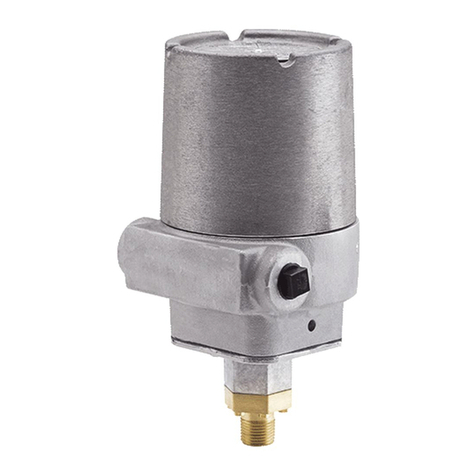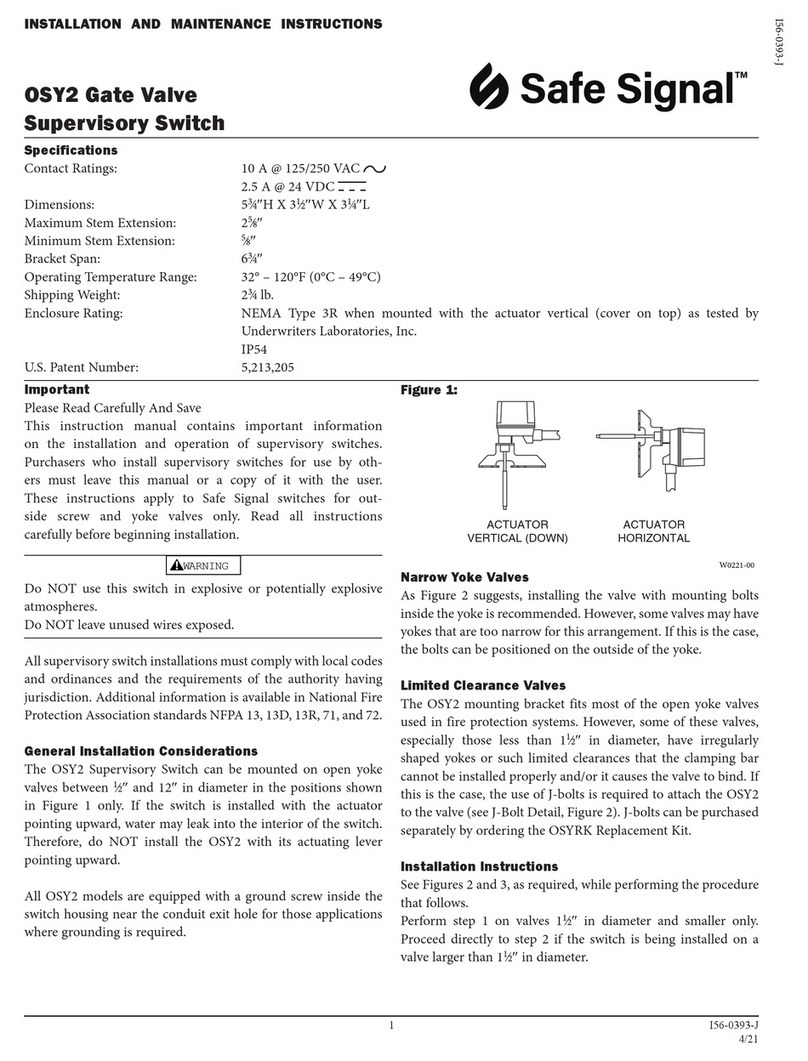
OS & Y
VALVE
WATER
BY-PASS
VALVE
LOCAL ALARM
SHUT OFF
VALVE
RETARD
WATER
MOTOR
GONG
EPS10EXP
WET
SYSTEM
ALARM
CHECK
VALVE
OS & Y
VALVE
WATER
BY-PASS
VALVE
LOCAL ALARM
SHUT OFF
VALVE
RETARD
WATER
MOTOR
GONG
EPS10EXP
DRY
SYSTEM
ALARM
CHECK
VALVE
OS & Y
VALVE
WATER
BY-PASS
VALVE
LOCAL ALARM
SHUT OFF
VALVE
WATER
MOTOR
GONG
CHECK
VALVE
EPS10
WET SYSTEM WET SYSTEM DRY SYSTEM
WIRE TO ALARM
INDICATING CIRCUIT
OF FIRE ALARM
CONTROL PANEL
INDICATING CIRCUIT
OF FIRE ALARM
CONTROL PANEL
INDICATING CIRCUIT
OF FIRE ALARM
CONTROL PANEL
TO
SPRINKLER
SYSTEM
TO
SPRINKLER
SYSTEM
TO
SPRINKLER
SYSTEM
FIGURE 2. TYPICAL PIPING DIAGRAM FOR EPS10-1, EPS10-2
W0171-01
FIGURE 3. SWITCH TERMINALS:
W0173-00
GROUND
SCREW
COM
B
A
TERMINALS
BREAK WIRE AS SHOWN FOR
SUPERVISION OF CONNECTION.
DO NOT ALLOW STRIPPED WIRE
LEADS TO EXTEND BEYOND
SWITCH HOUSING. DO NOT
SWITCH #1
SWITCH #2
SWITCH #2
LOCKING
SCREW
TERMINAL “A”
TERMINAL “B”
EPS10 EPS10
point setting by approximately 2.5 PSI. A reset differential of approximately 3
PSI is typical throughout the entire adjustment range of switch.
4. Retest the set point several times to ensure accuracy of setting.
5. Re-seat locking screw.
TABLE 2.
MODEL
FACTORY SETTINGS (PSI)
Fall
(Low Switch)
Approx.
Reset
Rise
(High Switch)
Approx.
Reset
EPS10-1 — — 4 – 8 3 PSI diff.
EPS10-2 — — 4 – 8 3 PSI diff.
NOTE: The sensor assembly is not field replaceable. Do not attempt to disassemble
these parts. If you have any questions, consult Safe Signal. Safe Signal rec-
ommends careful consideration of the following factors when specifying
and installing Alarm Pressure Switches. Always refer to the Installation and
Maintenance Instruction for specific recommendations on individual devices
before installing the unit.
• Electrical ratings stated in literature and on nameplates should not be exceeded.
• Overload on switch can cause failure on the first cycle. Always wire devices
according to national and local electrical codes.
• Install units away from shock and vibration. Proper electrical fittings should be
used to prevent moisture from entering the enclosure via the conduit.
• Test all devices for proper operation after initial installation. Perform preven-
tive maintenance and periodic testing as required by the applicable NFPA
standards but not less than bimonthly.
• Install a back-up control for all critical applications where control failure could
endanger life or property. A backup control to serve as a high or low limit
control is especially recommended for applications where a runaway condition
could result.
• Do not mount unit where ambient temperatures will exceed published limits.
• Avoid impact or mechanical loading.
ADJUSTMENTS TO FACTORY SETTINGS
Both EPS10-1 and EPS10-2 devices are pre-adjusted at the factory to alarm at 4–8
PSI on rising pressure (see Table 2). Pressure switch settings may be adjusted in the
field to obtain a different pressure alarm response from 4 PSI to 20 PSI. The switch
has an override feature on the adjustment mechanism to prevent exceeding the 20
PSI max. setting of the switch. This override feature carries with it a tolerance band
that may limit the upper adjustment to 16–20 PSI. Care must be used when setting
the switch to ensure that the lower limit of 4 PSI is not exceeded. This will allow the
switch to reset within the 3 PSI differential stated.
1. Install pressure switch as stated in “INSTALLATION” portion of instruction
manual. Attach pressure test source to system.
2. Back off locking screw (see Figure 1) to allow main adjustment wheel to rotate
freely.
3. Test trip point by slowly introducing pressure from the pressure test source.
When trip point is found, reduce pressure to zero. Rotate main adjustment
wheel (counterclockwise to increase pressure) and retest until switch trip point
is at the desired pressure setting (4–20 PSI range). Each number represents an
approximate trip point change of 0.2 PSI. One full rotation changes the trip
THREE-YEAR LIMITED WARRANTY
SAFE SIGNAL warrants that the equipment herein shall conform to said descriptions as to all af-
firmation of fact and shall be free from defects of manufacture, labeling, and packaging for a pe-
riod of three (3) years from the invoice date to the original purchaser, provided that representative
samples are returned to SAFE SIGNAL for inspection. Upon a determination by SAFE SIGNAL
that a product is not as warranted, SAFE SIGNAL shall, at its exclusive option, replace or repair
said defective product or parts thereof at its own expense except that Purchaser shall pay all
shipping, insurance, and similar charges incurred in connection with the replacement of the
defective product or parts thereof. This Warranty is void in the case of abuse, misuse, abnormal
usage, faulty installation, or repair by unauthorized persons, or if for any other reason SAFE
SIGNAL determines that said product is not operating properly as a result of causes other than
defective manufacture, labeling, or packaging.
2 I56-0551-L
4/21






















